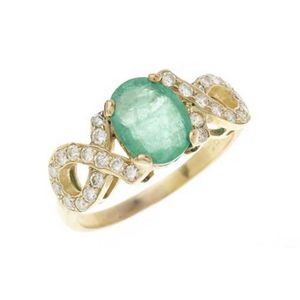Georgian Pink Gold Ring with Yellow Paste and Pearls
You must be a subscriber, and be logged in to view price and dealer details.
Subscribe Now to view actual auction price for this item
When you subscribe, you have the option of setting the currency in which to display prices to $Au, $US, $NZ or Stg.
- Georgian - As an English stylistic period, Georgian is usually taken to cover the period from George I (1714) to the Regency of Prince George (1811-20), although the period from 1800 to 1830 is sometimes designated as the Regency period. During the Georgian period the great English cabinetmakers and designers such as Chippendale, Hepplewhite, Adam Sheraton etc., were all active.
Therefore there isn't a single 'Georgian style' as such and to say something is 'Georgian', usually means it was made between 1714 and 1830. This assumes we discount George V and George VI, both being from the 20th century.
The styles popular at the time of each reign were:
George I (1714-1727) saw out the last years of the Baroque period.
George II (1727-1760) reigned during the Rococo period.
George III (1760-1820) saw the last gasp of the Rococo, all of the early Neo-Classic 'Adam style' and most of the later neo-Classic 'Regency style'.
George IV (Prince Regent 1820-1830)encompassed the last of the 'Regency' style.
William IV's reign (1830-1837) was something of a no man's land (stylistically) and he wasn't a 'George' anyway. He covered the last glimmerings of 'Regency' and the start of the 'Victorian' style. - Paste / Rhinestone / Diamante - Paste (or rhinestone or diamante) is the name given to a coloured glass composition used for imitation gemstones, or to imitation gemstones made of glass.
Although the technique of glassmaking had been known for thousands of years, but it wasn't until a lead glass with similar optical properties to diamonds were invented by a German jeweller working in Paris (either "Stras" or 'Strasser") in the early 18th century that "paste" gemstones became popular.
There was no social stigma attached to wearing imitation stones, and they were worn in situations where highway robbery was a possibility. The 18th century settings were of very high quality, equivilent to real gemstone jewellery.
In the nineteeth century the quality of paste jewellery declined and it has remained the poor cousin to genuine gemstones ever since.
This item has been included into following indexes:
Visually similar items

A garnet and pearl cluster ring; silver set on a later 15ct gold mount. Size Q.

A Chrysoberyl and diamond cluster ring, the oval faceted chrysoberyl of 4.05cts, surrounded by a border of old European cut diamonds totalling 1.60cts, in 18ct gold, ring size N.

An emerald and diamond ring, claw set with an oval cut emerald to looped shoulders set with 28 round brilliant cut diamonds, tests for 14ct, size T, wt 4.9g.

An antique ruby and diamond cluster ring, centrally set with a pear cut Burmese ruby of 0.55cts, surrounded by old European cut diamonds totalling 0.44cts, mounted in silver and 18ct gold, ring size K
